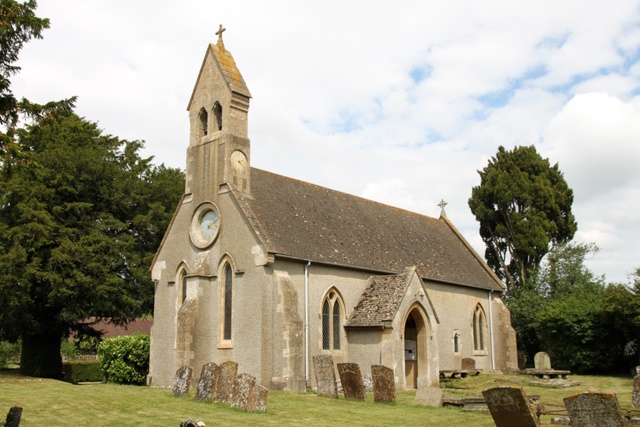


























The Church of St. Michael and All Angels, Newton Purcell
St. Michael's Church in Newton Purcell is a small stone structure covered with pebble dash. It comprises a continuous nave and chancel with a bell-gable at the west end. Originally a Romanesque building, the church was repaired and 'beautified' in 1813 at the cost of John Harrison of Shelswell House, when most of the ancient features were destroyed. A restoration by C. N. Beazley in 1875–6 at the expense of Edward Slater-Harrison and the rector, John Meade, almost amounted to a rebuilding, leaving only the foundations of the original walls. A 13th-century piscina survives and the present 12th-century doorway was moved from the north, where it is shown in Skelton's illustration, to the south side; it has chevron mouldings and a roughly carved tympanum of a dove and two interlocked snakes. The restoration also included the removal of the old pews and gallery, the restoration of the chancel, and the building of the bell-gable, vestry, and south porch. In 1875 a 13th-century incised stone, now on the north wall of the chancel, commemorating a heart burial and inscribed 'Hic jacet . . .' was discovered in a niche (probably the old aumbry) in the chancel wall. There are two lancet windows at the west end, and a window on the north side contains early 19thcentury glass after Raphael's 'Transfiguration'. The font and pulpit are modern. There are memorials to the Trotman, Harrison, and Slater-Harrison families, successive owners of Shelswell House. Those commemorated include Edward Trotman (d. 1743); his sons Samuel Trotman, rector (d. 1773), and Fiennes Trotman (d. 1782); Gilbert Harrison, merchant of London (d. 1790), with a marble bust and elaborate emblems of commercial enterprise; Mary, his widow (d. 1825), with a monument by P. Rouw of Regent Street; John Harrison (d. 1834); John Slater-Harrison (d. 1874); and Edward Slater-Harrison (d. 1911); and one to George Tyrwhitt-Drake (d. 1915). The church once had some medieval silver: a chalice and paten were listed in 1552. The chalice was doubtless the one presented by Leonard and Margaret Verney, who mentions it in her will of 1530. A pewter almsplate has disappeared since 1892, and the plate consisted in 1955 of a silver chalice and paten of 1798. In 1955 there were two bells, as there were in 1552; both are 14th-century, and one is inscribed 'Ave Maria Gracia Plena'. The registers begin in 1705, but there are transcripts for 1681–1705. The churchwardens' book begins in 1759. Historical information about St. Michael's Church is provided by 'Parishes: Newton Purcell', in A History of the County of Oxford: Volume 6, ed. Mary D Lobel (London, 1959), pp. 262-267. British History Online http://www.british-history.ac.uk/vch/oxon/vol6/pp262-267 [accessed 19 February 2023]. St. Michael's Church is a Grade II listed building. For more information about the listing see CHURCH OF ST MICHAEL, Newton Purcell with Shelswell - 1046423 | Historic England For more information about St. Michael's Church see Parishes: Newton Purcell | British History Online (british-history.ac.uk). |

